Ontario is home to a great variety of bird species. There are still many who are interested in learning more about the various species of ducks that can be found there.
Ducks are omnivores, eating a wide variety of animal and plant matter but mostly crustaceans, small fish, and aquatic insects. They will consume both terrestrial and aquatic vegetation.
Male ducks, called drakes, have more vivid plumage than their female counterparts. Female ducks are often referred to as ducks or hens. That is to say, the mallard may be traced back as the ancestor of all domesticated ducks.
In this article, we discuss types of duck species widespread throughout Ontario.
| Image | Name |
|---|---|
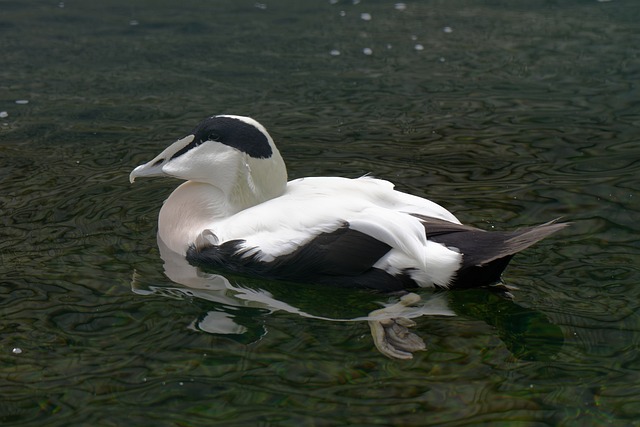 | Common Eider |
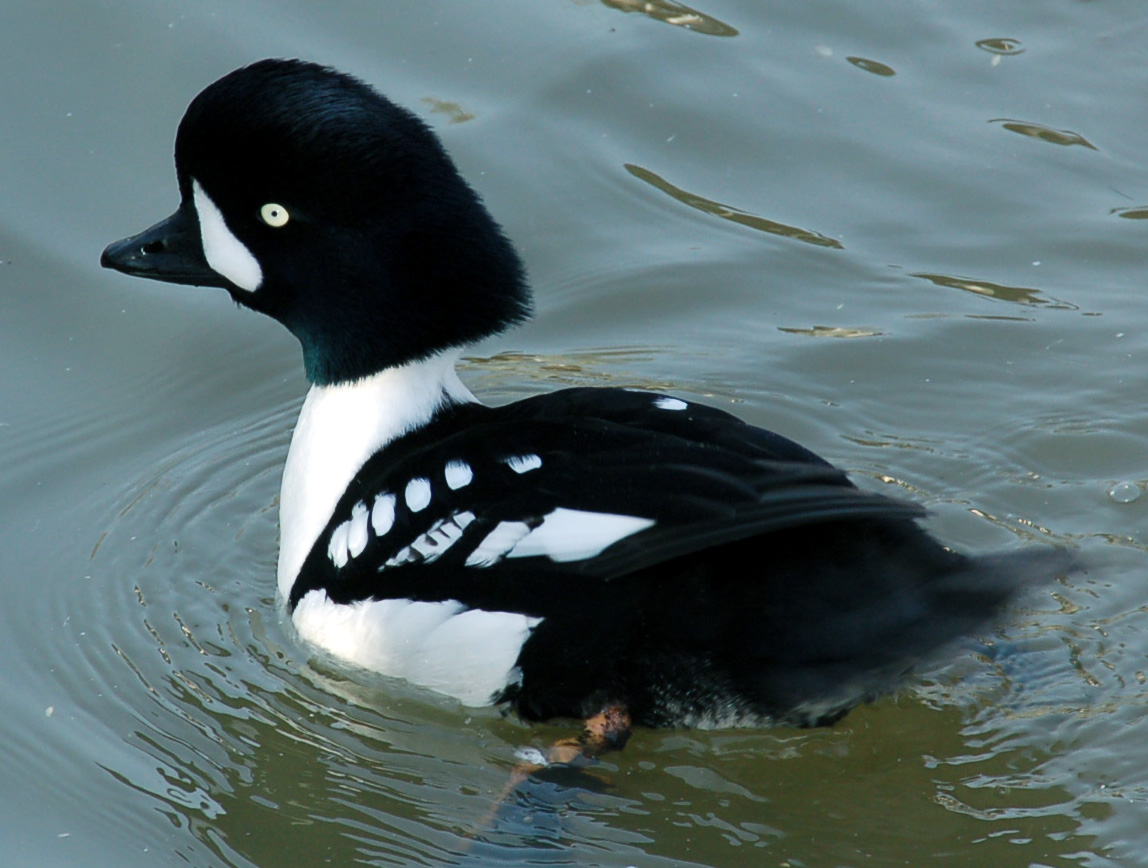 | Barrow's Goldeneye |
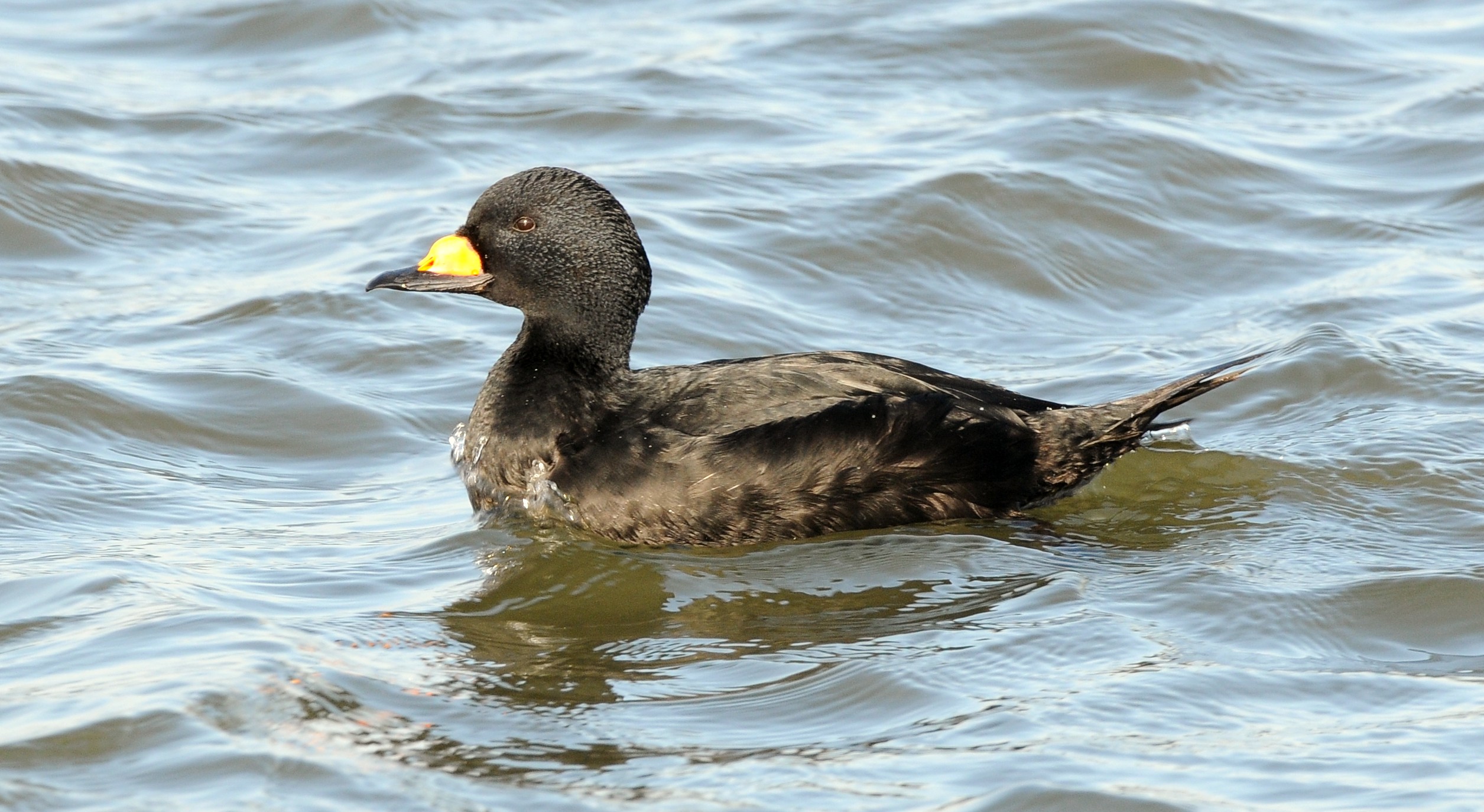 | Black Scoter |
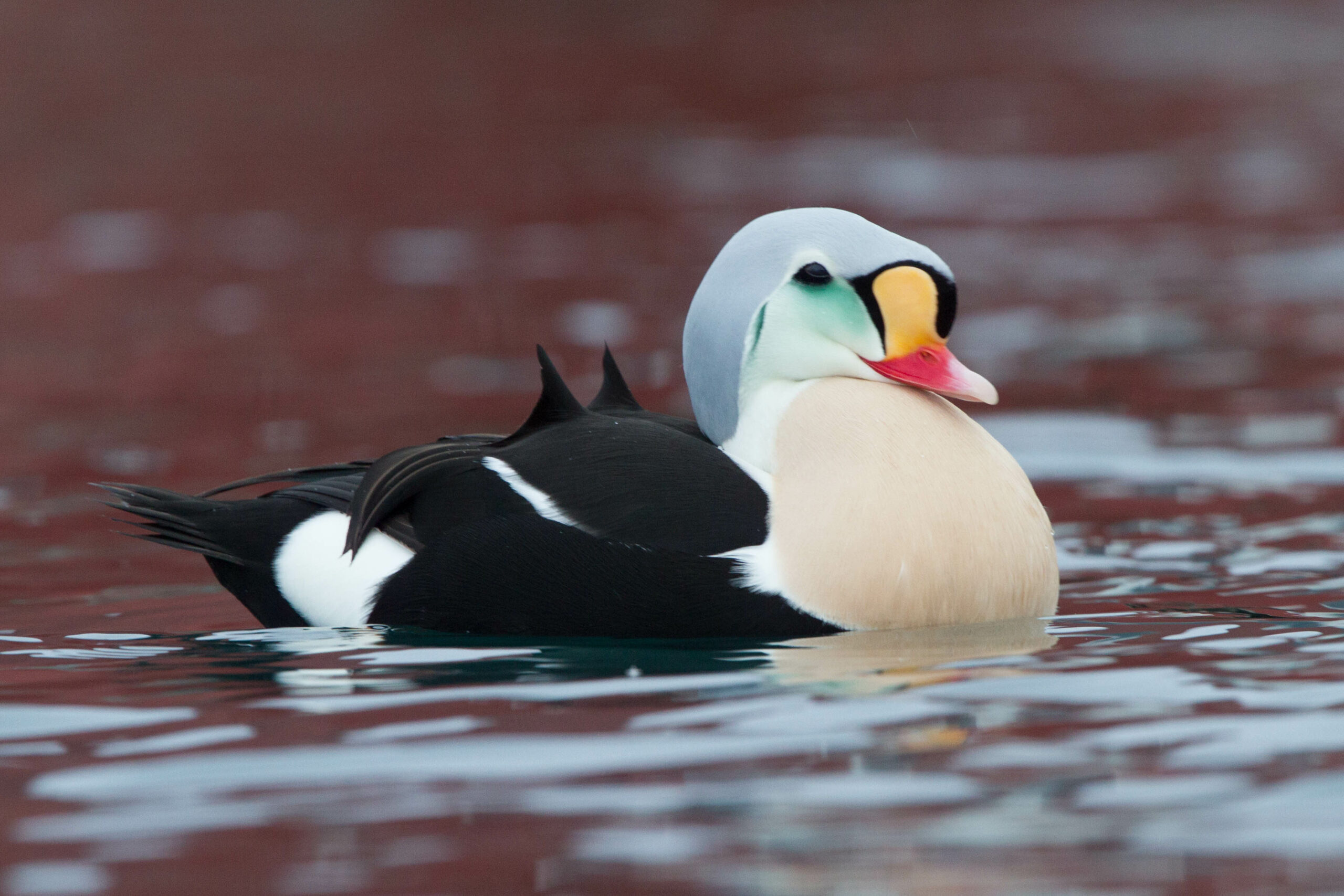 | King Eider |
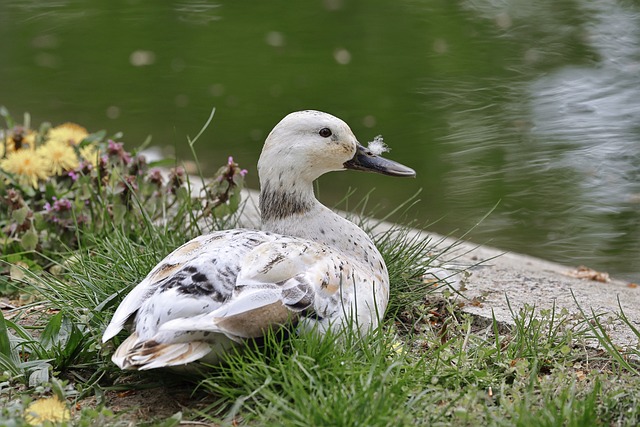 | Harlequin Duck |
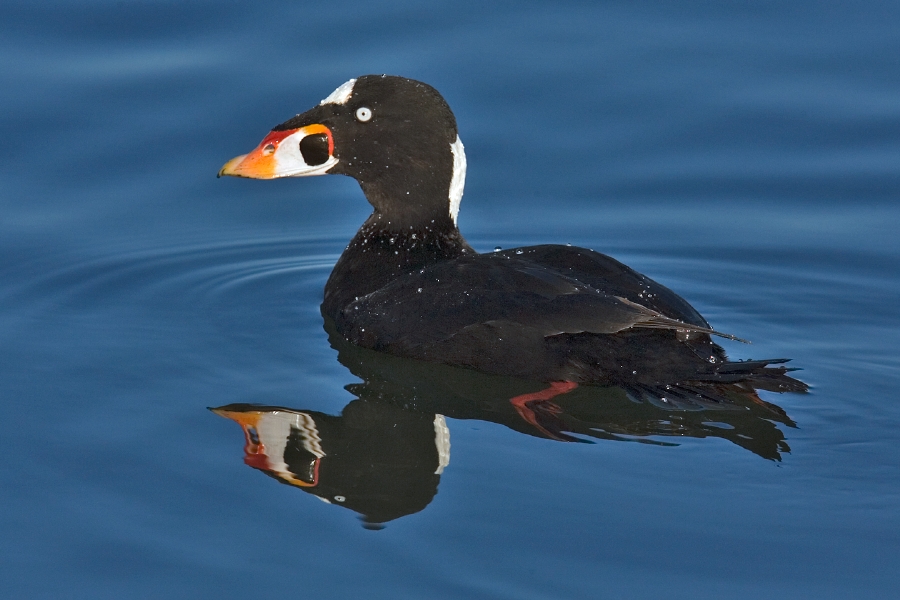 | Surf Scoter |
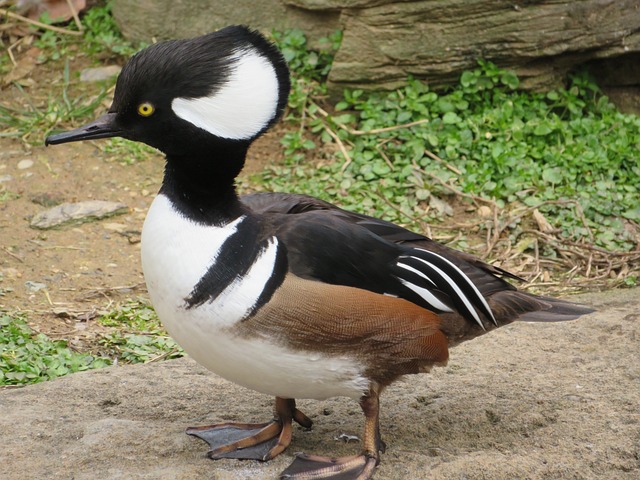 | Hooded Merganser |
 | Wood Duck |
Types of Ducks in Ontario
1. Common Eider

Even though the Common Eider is a bird that is considered to be in the process of becoming extinct across Ontario, it is still possible to see it year-round along the northern shore of the province.
The Common Eider is a huge sea duck that has a forehead that slopes downward. The faces and upper back of mating males are typically white, while their caps, sides, and abdomen are black, and their napes are a pistachio tone (neck backside).
The chests, upper back, and wings of females are barred with black, giving them an overall reddish-brown coloration.
The chests and backs of young and non-breeding males appear white to variable degrees, while the rest of their bodies have a chocolate-brown coloration.
Range
There are 6 subspecies of Common Eiders, 4 of which nest across North America. There are some minor changes between each of these four subspecies.
The breeding range of the Common Eider includes most of Alaska and Canada, as well as areas of Asia and northern Europe. Some travel south during the winter months, while others spend the whole year in those places.
Habitat & Food
Common Eiders are more likely to be found within saltwater or marine settings that are located in close proximity to rocky beaches. You may locate them in vast colonies during the mating season on islets, coastal islands, and shorelines that have shrubs, vegetation, and stunted forests.
During the winter, they make their homes in areas of the ocean with stony seafloors, making it easier for them to hunt for mollusks.
Mollusks, marine worms, fish eggs, and crustaceans make up the majority of a Common Eider’s diet. They hunt for food when the tide is low and use their powerful bills, which resemble chisels, to peel mussels off of rocks that are located underwater.
They are capable of eating the mussels in their entirety despite the shells that they have. When they feed on crabs, they only consume the body of the crustaceans and throw away all of their legs and claws before doing so.
2. Barrow’s Goldeneye

It is possible to see Barrow’s Goldeneyes across southern Ontario during the months of November and January, however, these birds are not particularly abundant in this region.
Appearance
Due to the striking similarity of their appearances, Common Goldeneyes and Barrow’s Goldeneyes are sometimes confused with one another. Barrow’s Goldeneyes are ducks of medium size.
The heads of male Barrow’s Goldeneyes are jet black and iridescent with a purple shine. They possess a white spot in the shape of a crescent located behind their dark beak.
They possess eyes that are a golden yellow color, and their chests and abdomen are white. They have white shoulder bands that stand out against their black upper half.
Female Barrow’s Goldeneyes are distinguished by their grey bodies, white collars over their throats, yellow-orange bills, dark brown heads, and golden yellow eyes that are characteristic of the species. Similar to the males, the females possess white spots on their wings.
Kids are quite identical to females, with the exception that they bear a fainter version of the mature males’ white crescent marking.
Before moving to the northern states of the United States and the western parts of Canada, Barrow’s Goldeneye spends their breeding season across Alaska, western Canada, and a few regions of eastern Canada along the coast.
Habitat & Food
Small hill ponds and lakes with surrounding mature trees that have nesting holes are ideal habitats for Barrow’s Goldeneyes. You may locate these birds in the mountains.
They will pause on beaches, estuaries, and inlets while they are on their journey. During the winter, you may locate them around the rocky coastlines of the seashore or the lakes inland.
During the mating season, Barrow’s Goldeneyes prefer to feed on aquatic insects. In fact, they will seek out environments that do not contain any fish that feed on invertebrates in the area so that they do not face any conflict for this particular sort of diet.
They will gorge themselves on mollusks, crabs, and tiny fish throughout the winter months.
Nesting sites for Barrow’s Goldeneyes are often cavities in cliffs or trees, or they take advantage of cavities already occupied by woodpeckers.
If there aren’t any holes present, they might choose to nest on the surface behind a shrub instead.
The female hatch six to twelve eggs, which she then incubates for close to a month.
After they have hatched, the mother brings the hatchlings to the area where there is food so that the young may fend for themselves. Sometimes one brood may mingle with another, especially if the mother departs early or the broods are involved in a territorial struggle between females. On other occasions, the female will keep her brood to herself.
It is feasible for you to get Barrow’s Goldeneyes to mate in the garden if you construct nesting boxes for them well in advance of the mating season.
3. Black Scoter

Throughout Ontario, the Black Scoter is a species that is considered to be in danger of extinction, although you may still see them from October through December.
Appearance
There is also a variation of this bird known as the American Scoter. The adult Black Scoter’s entire body is a black velvet color, without the brilliant yellow spot at the base of its beak. This gives the species its name, which is also rather fitting.
Female Black Scoters were not even remotely dark in coloration. The bottom part of their heads is lighter in color than the remainder of their bodies, which are a brown color generally. The tip of their bill appears black, and their head is a darkish brown color.
The term “juvenile” refers to a mixed group that includes both men and girls. They seem similar to females in terms of color and the black cap on their heads, however, males may be distinguished from females by the yellowish knob at the bottom of their bills.
Before traveling to the coastal regions of the United States, Black Scoters spend their breeding season across Alaska and Canada.
Habitat
Scoters de mer, also known as Black Scoters, are almost always found near saltwater, and more specifically around rocky beaches, in the wintertime or when traveling.
During the winter, they often congregate with different scoter species to create enormous flocks. They relocate to even more protected habitats, such as lakes and small ponds having vegetation around the margins during the time of year when they are breeding.
In the waters and bays along their shores, Black Scoters dive for mollusks and shellfish. In addition to mollusks and shellfish, they could also consume shrimp and crabs, along with various types of marine flora. They consume a lot of aquatic invertebrates and their eggs, as well as fish eggs and various kinds of plants, while they are in freshwater.
They are species that make a lot of noise and can be recognized in the winter by the steep whistle that all males make.
Nests of Black Scoters can often be tucked away in a crack in a rock or on the surface, where clumps of grasses shield them. They are often located less than one hundred feet away from the water. The female will first create a hole in the surface or grassland, then line it using her own plumage.
She will typically hatch between eight and nine eggs, which she will then incubate for roughly twenty-eight days. They will have her care for around three weeks, and then they will be left to care for themselves independently.
The annual migration of tens of thousands migrating Black Scoters to warmer climes in the south is a beautiful sight to see.
4. King Eider
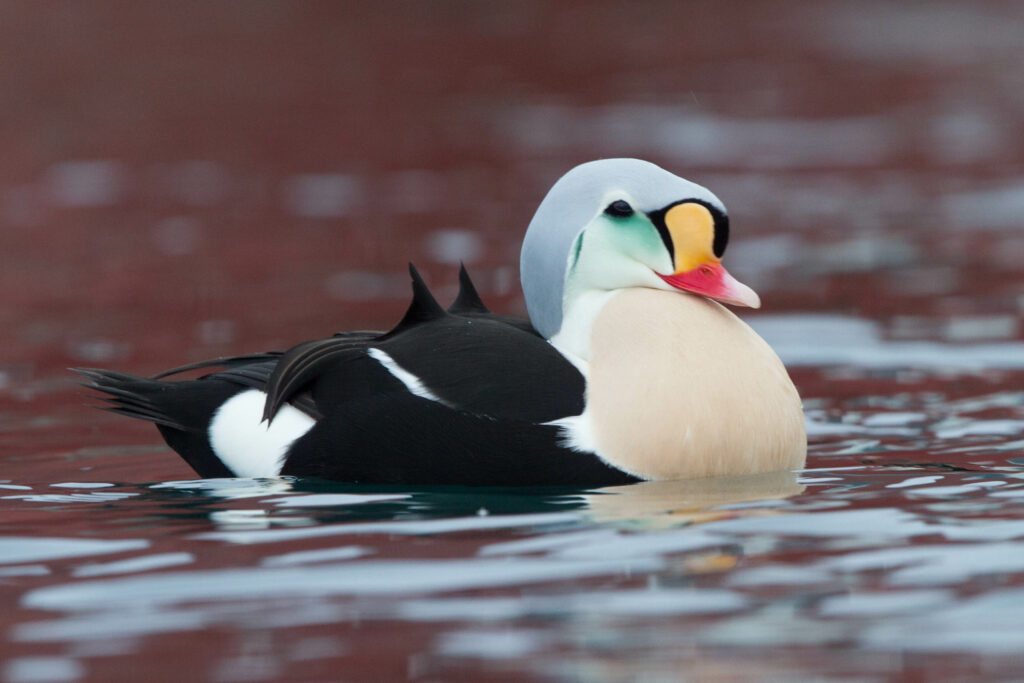
Even though King Eiders are seldom seen throughout Ontario, there are reports of sightings in the south of the province during the months of November and January.
Appearance
King Eider males are huge ducks that may be distinguished from other duck species by the orange spike with a black pattern that sits atop their otherwise short red beak.
Their face is green, while the rest of them, including the crest and nape, is a faint bluish. They have white bodies with black wings, abdomens, and backs. The underside of their tails and their wings are also white.
Browning occurs all over the body of a female King Eider, or Queen Eider as they’re often referred to. She has exquisite chevron designs on her sides and back and delicate, streaky markings on her neck and chest. The bill is jet black, whereas her otherwise brown face and neck are unremarkable.
The juveniles possess the dark brown coloring of the adults, but they also possess the males’ white breasts and orange beaks.
Breeding grounds for King Eiders are the coastal regions of northern Canada, but in the winter, they migrate to the eastern coast of Canada, the southern coast of Alaska, and the northeastern United States.
Habitat & Food
The King Eider is a seabird that may be found near water and on rocky shores and ocean waters in the arctic and subarctic regions. During the winter, they gather around coastal waters with other migrating birds and may number in the hundreds of thousands. During the spring and summer breeding seasons, you may find them at or near any body of fresh water.
King Eiders, while foraging at sea, will dive to the ocean floor in search of food. They could possibly hunt for food under the sea ice. When visiting ponds and lakes, they like to remain afloat while sieving the water for crustaceans, aquatic invertebrates, and algae.
The female King Eider constructs a ground nest close to water. Typically, these nests are scrapes made in the earth and covered with grasses and the female’s own plumage. They hatch between two to seven eggs, which the female incubates for around two weeks.
Every spring, a huge number of King Eiders make an incredible journey toward the Arctic to nest.
5. Harlequin Duck

From November through January, southern Ontario is a common location to see Harlequin Ducks.
Appearance
These little sea ducks, known as Harlequin Ducks, are undeniably eye-catching. Due to the variety of colors and patterns present on their bodies, they are easily distinguished. Males used for reproduction tend to be more vividly hued than their female counterparts.
Their tops and bottoms are a bluish-gray, and their tops and crowns are a ruddy red. They have white stripes that are edged in black over their breast, neck, and head, as well as a white mark in the center of each of their pupils. They possess white spots on their backs as well.
Males that aren’t actively trying to reproduce still exhibit the distinctive facial marks of breeding males, despite their brown bodies.
Females are brown all around, but they have three distinguishable white patterns on their heads: a spot atop the eye, a spot on the front of the bill, as well as a mark behind the eye.
Harlequin Ducks breed across coastal areas of eastern and western Alaska and Canada. And then migrate small distances to the coastlines of Canada and also the northeastern United States for the winter.
Harlequin Ducks are summer residents of swift mountain rivers, crashing waves, and white water. During the winter, they congregate along stony, wave-battered coastlines.
Habitat & Food
The Harlequin Duck is a skilled swimmer and diver who has adapted well to its hard environment. They are adept at swimming against the tide and diving for food beneath the sea.
In doing so, they risk being thrown against the rocks by the churning waters. They feast on marine worm larvae, mollusks, and tiny fish. River bottom invertebrates are another favorite food.
Harlequin ducks typically build their nests on land close to bodies of water. They might be hiding under a hollowed-out tree, an old stump, or a crack in the rock.
They often consist of little more than a small hole covered with feathers and surrounded by grass, twigs, and plants. The female hatches between three and ten eggs, which she must then tend for almost a month.
Due to their similarity in sound to a mouse, harlequin ducks are often referred to by the name “Sea Mouse.” Due to their vivid plumage, they are also known as “painted ducks.”
6. Surf Scoter

Although uncommon, Surf Scoters may sometimes be seen across Ontario throughout the winter months of October through April.
Appearance
The adult Surf Scoter, a medium-sized bird with black, velvety plumage, is frequently referred to as an “ancient skunk-head coot” due to the white spots on his forehead and neck.
In addition to these traits, male surf scoters are easily distinguished by their huge orange beak that is marked with red, white, and yellow. There is a big black mark at the bottom of the bill. Their pupils are pure white.
Female Surf Scoters are typically darker overall than males, although they share the same white spot at the bill’s bottom and behind the eyes. The only difference is that the female has a thinner, grayer version of the male’s bill.
Young birds are similar to adult males in appearance, with a brownish body, black eyes, and a beak that is similarly colored and shaped.
Originally from the Arctic, Surf Scoters now migrate to the beaches of both the United States and Canada to reproduce.
Habitat & Food
Forests close to freshwater lakes are nesting grounds for Surf Scoters. During the molting season, they go into protected, shallow areas like inlets, bays, and estuaries where there is enough food and few predators. Although in the winter, they are probably out on the water.
To forage for food, Surf Scoters often plunge under the waves. They also modify their search strategies in response to changes in food availability.
During spawning, for example, they choose to eat Pacific Herring eggs because it requires less work and yields a larger meal. Freshwater insects and crustaceans are abundant throughout the mating season.
Nests of Surf Scoters are often constructed on the surface, hidden by dense vegetation or short tree branches, and aren’t always located near water.
About 5 to 8 are hatched by the female after she has dug a bowl-shaped pit in the soil and lined it with grasses and down plumage. Some broods might just get confused because of overcrowding in breeding regions.
Sometimes, gulls may attempt to take the food that Surf Scoters have caught via their diving. That’s why it’s so unusual to see a single bird in a flock, and birds often dive and surface in unison to prevent theft.
7. Hooded Merganser

It’s possible to see a Hooded Merganser throughout Ontario at any time of the year. Only 2% of summer checklists have them, whereas 4% of winter ones do.
The Hooded Merganser seems to be the tiniest of the Merganser species and therefore is found nowhere else in the world except in North America.
Appearance
Male Hooded Mergansers were visually remarkable ducks since they could alter the shape of their heads and the design of their crests by raising and lowering crests on their heads.
When their crests remain open, they seem like enormous white patches, whereas when they get closed, they look like a solid white line.
They possess black heads with white crests and bright yellow eyes. Their white breast and cinnamon sides set them out from the rest of their black bodies. They get a pair of black bands across their breast and a pair of white bars across their hips.
The only difference is that females’ crests are ruddy brown instead of black. Their whole bodies are a uniform brownish-grey color, with a lighter underside and a darker top.
Compared to men, their eyes are less bright. The top halves of juveniles are black, while the bottom halves are brownish-gray.
Hooded Mergansers spend the winter in western Canada and spend the rest of the year in the eastern United States. Furthermore, they remain across southern Canada for the whole year.
They may be seen in the Midwest during migration and in southern and western regions throughout the winter.
Habitat & Food
Hooded mergansers inhabit freshwater environments, including ponds, lakes, and slow-moving rivers. They breed in wetlands and estuaries having dense vegetation near forests.
They travel across a variety of environments, from the open sea to coastal beaches and tidal creeks, throughout their annual journey. They spend the colder months of the year in saltwater environments, including bay and inlets, as well as brackish marshes.
Underwater diving is how Hooded Mergansers find their food. Their curved and serrated bill helps them capture their prey. Fishes, aquatic bugs, and crustaceans, especially crayfish, are among their preferred foods. They might consume aquatic plants, seeds, and amphibians in wooded areas.
During courting, male Hooded Mergansers create a frog-like croak, while females produce a flying cry.
The Hooded Merganser typically nests within tree holes that are between ten and twenty feet from the ground. They often have nothing but down feathers for insulation and are located near or on water.
After a female gets finishes laying her eggs, she will immediately begin incubating her clutch of 7 to 15 eggs. About 30 days is the average time for the incubation phase.
After twenty-four hrs of hatching, the babies leave the nest and make their way to a nearby body of water. They are self-sufficient in that they have the ability to swim and forage for food. For the next several weeks, the female will continue to care for them and guide them to food-rich locations.
Foraging for food is made easier for Hooded Mergansers due to their excellent underwater vision.
8. Wood Duck

The months of March through November are prime time for seeing Wood Ducks across Ontario. Some, though, remain for the duration of the whole year. Only 8% of summer bucket lists don’t include them on there.
Appearance
Beautiful green crowns, a black and white body, and bright red eyes distinguish adult Wood Ducks from other duck species. Yes, they are birds with beautiful hairstyles.
They have reddish-brown breasts, brownish backs, buff flanks, and brown tails, having white patterns and blue flashes on occasion.
Brown bodies, greyish foreheads, and white surrounding black eyes characterize the females. The speculum, or bluish spots, on their wings are distinctive.
Common habitats for wood ducks include the eastern United States, the western coast, and the north and west. North American Wood Ducks spend the winter mostly in the southern United States and Mexico, where they reproduce in the spring.
Food
Wood Ducks are aquatic birds that may be found in forested swamps; they prefer to feed on fruit, seeds, and bugs while in the water but will also land in meadows and woodlands if necessary.
To communicate, male Wood Ducks utter a rising whistle, while females produce a unique two-note sound.
Wood Ducks build their nests within tree holes about 60 feet from the ground, frequently near bodies of water. Females use down feathers gathered from their breasts to line the nest. After four to five weeks, they lay eggs, and the babies utilize their clawed legs to crawl out before leaping to freedom.
It’s not uncommon for female Wood Ducks to abandon their nests and deposit their eggs in the ones of other female Wood Ducks.
Conclusion
The several species of ducks that may be found across Ontario are discussed in detail here. I have high hopes that this article may aid in the identification of many duck species found in Ontario.
There is a good chance that you will only observe ducks from a far distance, that they will be confused with members of other species, and that the lighting will not be ideal.
Learning “where are the white color” is the most effective strategy for recognizing ducks, particularly when you are looking at them from a distance.
The white spots seen on ducks are easily identifiable and may speed up the process of determining which kind of duck you have observed.
FAQ
Can you describe the appearance of a bufflehead duck?
The body of a bufflehead is white, while the rear of the bird is black, and the forehead is dark, having a huge white spot that loops around the head back. Females and males in their first year have a gray-brown body color with a white cheek band in the shape of an oval.
Is there a smartphone app that can recognize ducks?
Maintain your connection throughout the year. Everyone who enjoys waterfowl hunting and supports Ducks Unlimited should have a copy of the Ducks Unlimited smartphone app on their mobile device.
Some of the most significant parts include the DU Migration Chart, the Sunrise/Set countdown, the Waterfowler’s Blog, Waterfowl ID, and much more. DU Members also get access to additional services.
Last Updated on March 22, 2023 by Lily Aldrin
